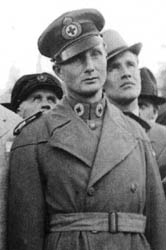

Luutnantti Carl-Gustaf Ericsson von Rosen


Luutnantti Carl-Gustaf Ericsson von Rosen

19 August 1909 – 13 July 1977
Carl-Gustaf von Rosen from Rockelstad was born on 19 August 1909 in Helgesta.
He served as an Ambulance-pilot in Abyssinia before joining KLM.
When the Winter War started he volunteered for service in the Finnish Air Force and he also presented the Finnish Air Force with three aircraft, one Douglas DC-2 (DO-1) and two Koolhoven FK.52 (KO-129 and KO-130), which he had bought for 250 000 Swedish kronor from KLM. The money had given by his mothers cosine John Henry Sager.
He served in Finland as a pilot in LeLv 44 in LeR 4 from 28 February to 31 March 1940. This unit was equipped with Bristol Blenheims and the DC-2 presented by von Rosen. During this period he flew one bombing mission in DO-1.
This mission took place on 1 March when they attack a Soviet airbase behind enemy lines. The crew consisted by the pilot von Rosen, the Finnish co-pilot Skorpa, the Norwegian mechanic/gunner Arvid Christiansen and the Finnish bombardier/observer Rolf “Rolle” Winqvist.
DO-1 was later named “Hanssin Jukka” and used by the Finnish Fieldmarshal Mannerheim as an stabs aircraft during the Continuation War.
On 8 March 1940, he received the Finnish Aviation Badge ("Wings").
He was decorated with the Vapaudenristi 3 (the Finnish Cross of Freedom 3rd Class) on 10 April 1940 for his service in Finland
Nothing more is known about von Rosen's service in Finland.
He was married on 3 July 1943.
After the war, he returned to Ethiopia to help create this country's Air Force.
Carl-Gustaf von Rosen was killed in Gode, Ethiopia on 13 July 1977 by Somalia-supported guerrilla.
He is buried at the Gulale Cemetery in Addis Abeba.
A curious fact is that his father Count Eric von Rosen was brother-in-law to Herman Göring.
Eric von Rosen was also the one who presented the Finnish Air Force with its first aircraft when he presented them with a Morane Parasol on 6 March 1918 during the Finnish Civil War. The aircraft was painted with the count's personal lucky sign - the blue swastika and the Finnish Air force used this sign from this on until the end of the Second World War, i.e. the Finnish swastika has nothing to do with Nazism.
Sources:
Carl-Gustaf von Rosen - Ralph Herrmanns, 1975, Wahlström & Widstrand, Stockholm, ISBN 91-46-12370-9
Svensk KLM-flygare som frivillig till Finland - Flygtidningen 15 December 1943
Sveriges Dödbok 1947-2006 – Sveriges Släktforskarförbund
Article by Eino Ritaranta in "Suomen Ilmailuhistoriallinen Lehti" no. 1/1996 kindly provided by Carl-Fredrik Geust
Additional information kindly provided by Carl-Fredrik Geust


